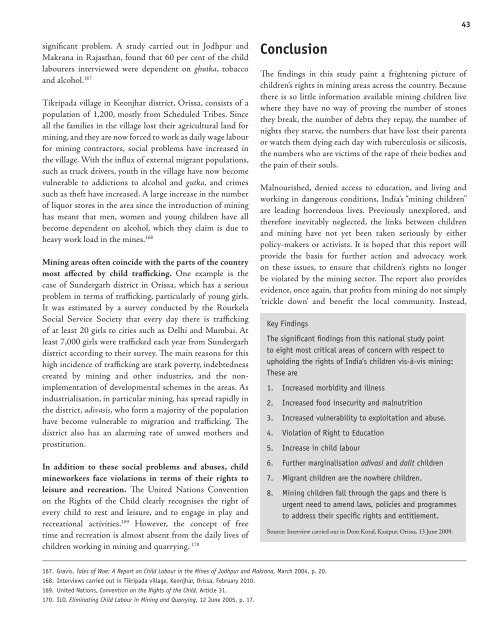Children - Terre des Hommes
Children - Terre des Hommes
Children - Terre des Hommes
Create successful ePaper yourself
Turn your PDF publications into a flip-book with our unique Google optimized e-Paper software.
43<br />
significant problem. A study carried out in Jodhpur and<br />
<br />
labourers interviewed were dependent on ghutka, tobacco<br />
and alcohol. <br />
Tikripada village in Keonjhar district, Orissa, consists of a<br />
population of 1,200, mostly from Scheduled Tribes. Since<br />
all the families in the village lost their agricultural land for<br />
mining, and they are now forced to work as daily wage labour<br />
for mining contractors, social problems have increased in<br />
the village. With the influx of external migrant populations,<br />
such as truck drivers, youth in the village have now become<br />
vulnerable to addictions to alcohol and gutka, and crimes<br />
such as theft have increased. A large increase in the number<br />
of liquor stores in the area since the introduction of mining<br />
has meant that men, women and young children have all<br />
become dependent on alcohol, which they claim is due to<br />
heavy work load in the mines. <br />
Mining areas often coincide with the parts of the country<br />
most affected by child trafficking. One example is the<br />
case of Sundergarh district in Orissa, which has a serious<br />
problem in terms of trafficking, particularly of young girls.<br />
It was estimated by a survey conducted by the Rourkela<br />
Social Service Society that every day there is trafficking<br />
of at least 20 girls to cities such as Delhi and Mumbai. At<br />
<br />
district according to their survey. The main reasons for this<br />
high incidence of trafficking are stark poverty, indebtedness<br />
created by mining and other industries, and the nonimplementation<br />
of developmental schemes in the areas. As<br />
industrialisation, in particular mining, has spread rapidly in<br />
the district, adivasis, who form a majority of the population<br />
have become vulnerable to migration and trafficking. The<br />
district also has an alarming rate of unwed mothers and<br />
prostitution.<br />
In addition to these social problems and abuses, child<br />
mineworkers face violations in terms of their rights to<br />
leisure and recreation. The United Nations Convention<br />
on the Rights of the Child clearly recognises the right of<br />
every child to rest and leisure, and to engage in play and<br />
recreational activities. However, the concept of free<br />
time and recreation is almost absent from the daily lives of<br />
children working in mining and quarrying. <br />
Conclusion<br />
The findings in this study paint a frightening picture of<br />
children’s rights in mining areas across the country. Because<br />
there is so little information available mining children live<br />
where they have no way of proving the number of stones<br />
they break, the number of debts they repay, the number of<br />
nights they starve, the numbers that have lost their parents<br />
or watch them dying each day with tuberculosis or silicosis,<br />
the numbers who are victims of the rape of their bodies and<br />
the pain of their souls.<br />
Malnourished, denied access to education, and living and<br />
working in dangerous conditions, India’s “mining children”<br />
are leading horrendous lives. Previously unexplored, and<br />
therefore inevitably neglected, the links between children<br />
and mining have not yet been taken seriously by either<br />
policy-makers or activists. It is hoped that this report will<br />
provide the basis for further action and advocacy work<br />
on these issues, to ensure that children’s rights no longer<br />
be violated by the mining sector. The report also provi<strong>des</strong><br />
evidence, once again, that profits from mining do not simply<br />
‘trickle down’ and benefit the local community. Instead,<br />
Key Findings<br />
The significant findings from this national study point<br />
to eight most critical areas of concern with respect to<br />
upholding the rights of India’s children vis-à-vis mining:<br />
These are<br />
1. Increased morbidity and illness<br />
2. Increased food insecurity and malnutrition<br />
3. Increased vulnerability to exploitation and abuse.<br />
4. Violation of Right to Education<br />
5. Increase in child labour<br />
6. Further marginalisation adivasi and dalit children<br />
7. Migrant children are the nowhere children.<br />
8. Mining children fall through the gaps and there is<br />
urgent need to amend laws, policies and programmes<br />
to address their specific rights and entitlement.<br />
<br />
167. Gravis, Tales of Woe: A Report on Child Labour in the Mines of Jodhpur and Makrana, March 2004, p. 20.<br />
168. Interviews carried out in Tikripada village, Keonjhar, Orissa, February 2010.<br />
169. United Nations, Convention on the Rights of the Child, Article 31.<br />
170. ILO, Eliminating Child Labour in Mining and Quarrying, 12 June 2005, p. 17.






